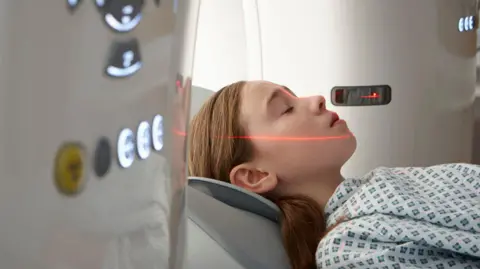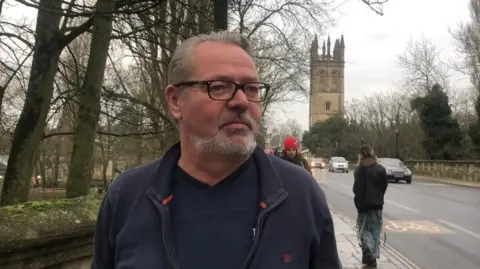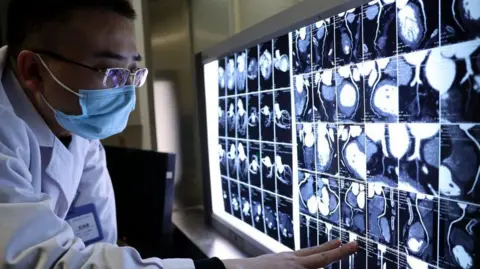
[ad_1]
Generation Reporter
 Getty Pictures
Getty PicturesThat is the 6th characteristic in a six-part collection this is taking a look at how AI is converting clinical analysis and coverings.
When 58-year-old Will Studholme ended up in twist of fate and emergency at an NHS sanatorium in Oxford in 2023 with gastrointestinal signs, he wasn’t anticipating a analysis of osteoporosis.
The illness, strongly related to age, reasons bones to turn into vulnerable and fragile, expanding the chance of fracture.
It became out that Mr Studholme had a serious case of meals poisoning, however early in his ailment’s investigation, he won an belly CT scan.
That scan was once then later run via synthetic intelligence (AI) era which recognized a collapsed vertebra in Mr Studholme’s backbone, a commonplace early indicator of osteoporosis.
Additional checking out ensued, and Mr Studholme emerged now not most effective along with his analysis, however a easy remedy: an annual infusion of an osteoporosis drug this is anticipated to toughen his bone density.
“I believe very fortunate,” says Mr Studholme, “I don’t believe this might had been picked up with out the AI era.”
 Will Studholme
Will StudholmeIt is not extraordinary {that a} radiologist would possibly be aware one thing incidental in a affected person’s imaging – an undetected tumour, a priority with a selected tissue or organ – outdoor of what they’d initially been checking for.
However making use of AI within the background to systematically comb via scans and mechanically establish early indicators of commonplace preventable persistent sicknesses that may well be brewing – irrespective of the explanation the scan was once initially ordered – is new.
The medical use of AI for opportunistic screening or opportunistic imaging, because it is named, “is solely starting” notes Perry Pickhardt, a professor of radiology and clinical physics on the College of Wisconsin-Madison, who’s amongst the ones creating the algorithms.
It is thought of as opportunistic as it takes good thing about imaging that has already been carried out for every other medical function – be it suspected most cancers, chest an infection, appendicitis or stomach ache.
It has the possible to catch up to now undiagnosed sicknesses within the early phases, earlier than onset of signs, when they’re more straightforward to regard or save you from progressing. “We will keep away from numerous the loss of prevention that we’ve got ignored out on up to now,” says Prof Pickhardt.
Common physicals or blood exams regularly fail to pick out up those sicknesses, he provides.
 Getty Pictures
Getty PicturesThere may be numerous knowledge in CT scans associated with frame tissues and organs that we do not in point of fact use, notes Miriam Bredella, a radiologist at NYU Langone who may be creating algorithms within the box.
And whilst research of it might theoretically be carried out with out AI by way of radiologists making measurements – it will be time eating.
There also are advantages of the era on the subject of lowering bias, she notes.
A illness like osteoporosis, as an example, is regarded as most commonly affecting skinny, aged white girls – so docs do not at all times assume to appear outdoor of that inhabitants.
Opportunistic imaging, however, does not discriminate that method.
Mr Studholme’s case is a superb instance. Being somewhat younger for osteoporosis, male and and not using a historical past of damaged bones, it’s not going he would had been recognized with out AI.
Along with osteoporosis, AI is being skilled to assist opportunistically establish middle illness, fatty liver illness, age-related muscle loss and diabetes.
Whilst the primary center of attention is on CT scans, as an example of the stomach or chest, paintings is going down to opportunistically glean data from different forms of imaging too, together with chest x-rays and mammograms.
The algorithms are skilled on many 1000’s of tagged earlier scans, and it’s important the educational knowledge contains scans from a large swathe of ethnic teams if the era goes to be deployed on a various vary of other people, pressure the professionals.
And there’s intended to be a degree of human evaluate – if the AI reveals one thing suspect it will be despatched to radiologists to verify earlier than it’s then reported directly to docs.

The AI era used to inspect Mr Studholme’s scan belongs to Israeli corporate Nanox.AI, which is one in all just a handful of businesses running on AI for opportunistic screening – way more are involved in the usage of AI to help within the correct and swift diagnoses of the precise stipulations the scans are in truth performed for.
Nanox.AI gives 3 opportunistic screening merchandise geared toward serving to establish osteoporosis, middle illness and fatty liver illness respectively from regimen CT scans.
Oxford NHS hospitals started trialling Nanox.AI’s osteoporosis targeted product in 2018 earlier than formally rolling it out in 2020.
Effects from Oxford hospitals display an as much as six-fold building up above the NHS moderate within the selection of sufferers being recognized with vertebral fractures – sufferers that may then be checked for osteoporosis, and get started remedy to fight the illness, says Kassim Javaid, a professor of osteoporosis and uncommon bone sicknesses on the College of Oxford who has spearheaded the set of rules’s advent.
Additional trials of the set of rules also are now underway at hospitals in Cambridge, Cardiff, Nottingham, Southampton and Bradford. “We need to construct the proof to make use of it around the NHS,” says Prof Javaid.
But whilst the era can get advantages folks, there are wider ramifications that wish to be regarded as says Sebastien Ourselin, a professor of healthcare engineering at Kings Faculty London, who heads the AI Centre for Price Primarily based Healthcare.
A large downside that must be balanced, he notes, is the additional affected person numbers that the usage of the era can create. “That is expanding the call for at the healthcare machine now not lowering it,” he says.
First, people who find themselves flagged by way of the opportunistic screening as probably having a illness will most probably want additional confirmatory checking out, which takes assets. And, if the AI is wrong or too delicate, that might lead to numerous needless checking out.
Then products and services wish to be in position for the ones additional those who do finally end up being recognized.
The additional load is a problem that incorporates the era admits Prof Javaid – however there are answers.
Sufferers showed to have the fractures in Oxford are routed for apply as much as a in large part nurse delivered fracture prevention carrier in order to not overload docs. “The AI does pressure you to switch your pathway,” he says.
And in the end, believes Prof Javaid, to have a better selection of other people with early-stage osteoporosis recognized and receiving the preventative remedy they want will save the NHS cash. “Fracture is likely one of the best causes other people finally end up in sanatorium,” he says.
Mr Studholme has observed the devastation of osteoporosis first hand: it resulted in his mom breaking each her hips. It used to simply be regarded as an outdated individual’s situation with not anything which may be carried out, he says. “I believe relatively privileged I will be able to do one thing earlier than my bones develop into chalk,” he says.
[ad_2]
